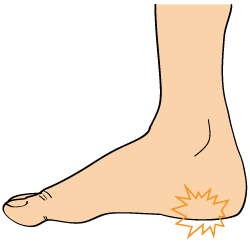Signs and symptoms of plantar fasciitis:

Plantar Fasciitis is also closely related to the working order of the lower leg, more specifically, gastrocnemius, soleus, flexor hallicus longus, and the achillies tendon. Trauma in this are can easily refer to the foot.
So what can be done through acupuncture and to alleviate the symptoms of plantar fasciitis? Usually the standard measures of acute care are applied such as: RICE protocol, anti-inflammatories, and stretching. Acupuncture treatments should be twice a week for at least three weeks. Treatments should focus on Kidney and Bladder meridian pathologies due to the location of the pain. Systemically there is likely qi and blood stagnation with the possibility of heat. Work to nourish blood, move qi and clear any local heat.
Eighteen patients attending an orthopaedic outpatient clinic with a year or more's history of heel pain due to plantar fasciitis were studied. All had had conservative treatment of physiotherapy and shoe-support without significant pain relief before acupuncture was offered, and thus acted as their own controls for the purposes of the study. The following traditional points were needled: Taixi (KI.3), Kunlun (BL.60) and Sanyinjiao (SP.6). Pain was assessed by a 100mm visual analogue scale (VAS) before treatment was started and after four, weekly sessions of acupuncture treatment. If complete pain relief was not obtained by the initial four-week treatment, a further two, weekly sessions of the above mentioned acupoints, with the addition of trigger point acupuncture in the gastro-soleus and plantar fascia, was carried out and pain assessed.
- Pain on the plantar surface of the heel.
- Heel pain that radiates to the toes.
- Stiffness of the plantar aspect of the foot.
- Pain early in the morning with initial steps or pain with walking after prolonged sitting.
- Pain is alleviated with activity but quickly returns.

Plantar Fasciitis is also closely related to the working order of the lower leg, more specifically, gastrocnemius, soleus, flexor hallicus longus, and the achillies tendon. Trauma in this are can easily refer to the foot.
So what can be done through acupuncture and to alleviate the symptoms of plantar fasciitis? Usually the standard measures of acute care are applied such as: RICE protocol, anti-inflammatories, and stretching. Acupuncture treatments should be twice a week for at least three weeks. Treatments should focus on Kidney and Bladder meridian pathologies due to the location of the pain. Systemically there is likely qi and blood stagnation with the possibility of heat. Work to nourish blood, move qi and clear any local heat.
Eighteen patients attending an orthopaedic outpatient clinic with a year or more's history of heel pain due to plantar fasciitis were studied. All had had conservative treatment of physiotherapy and shoe-support without significant pain relief before acupuncture was offered, and thus acted as their own controls for the purposes of the study. The following traditional points were needled: Taixi (KI.3), Kunlun (BL.60) and Sanyinjiao (SP.6). Pain was assessed by a 100mm visual analogue scale (VAS) before treatment was started and after four, weekly sessions of acupuncture treatment. If complete pain relief was not obtained by the initial four-week treatment, a further two, weekly sessions of the above mentioned acupoints, with the addition of trigger point acupuncture in the gastro-soleus and plantar fascia, was carried out and pain assessed.
Patients were also assessed with a verbal rating score to indicate the percentage improvement after acupuncture compared to before treatment. The mean duration of heel pain was 25.11 months (SD 10.68). The VAS data obtained at 4 and 6 weeks of acupuncture treatment showed a statistically highly significant improvement compared to the VAS before acupuncture (p < 0.0009 and p < 0.0001 respectively). Using the Mann-Whitney test, there was a statistically significant difference in VAS obtained at 6 weeks, after trigger point acupuncture had been added for poor responders, compared to that obtained after the first 4 weeks of acupuncture treatment (p < 0.047). Our study demonstrates that acupuncture is effective in treating patients with chronic heel pain due to plantar fasciitis and that the addition of trigger point acupuncture in poor or non-responders may be useful.